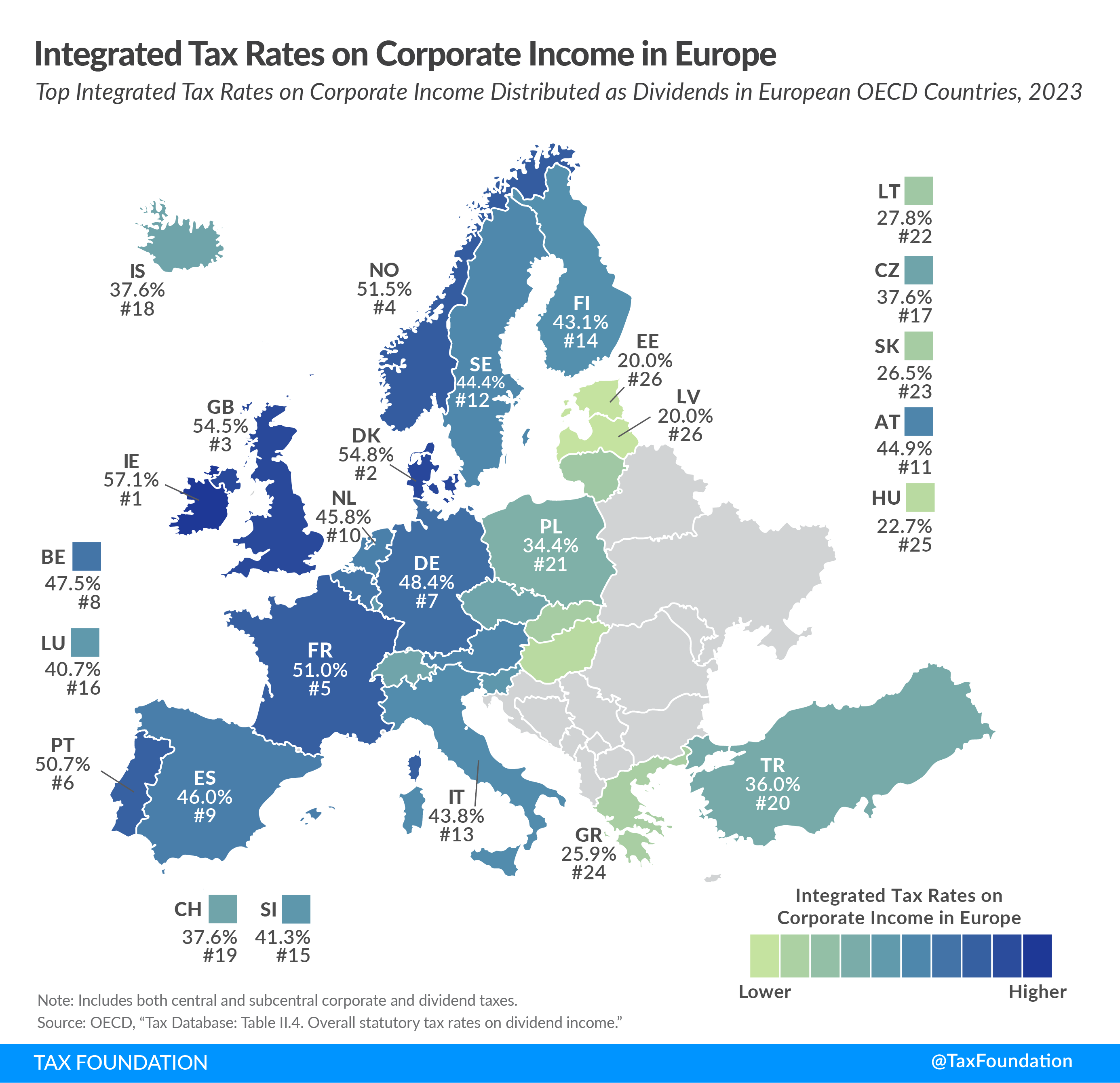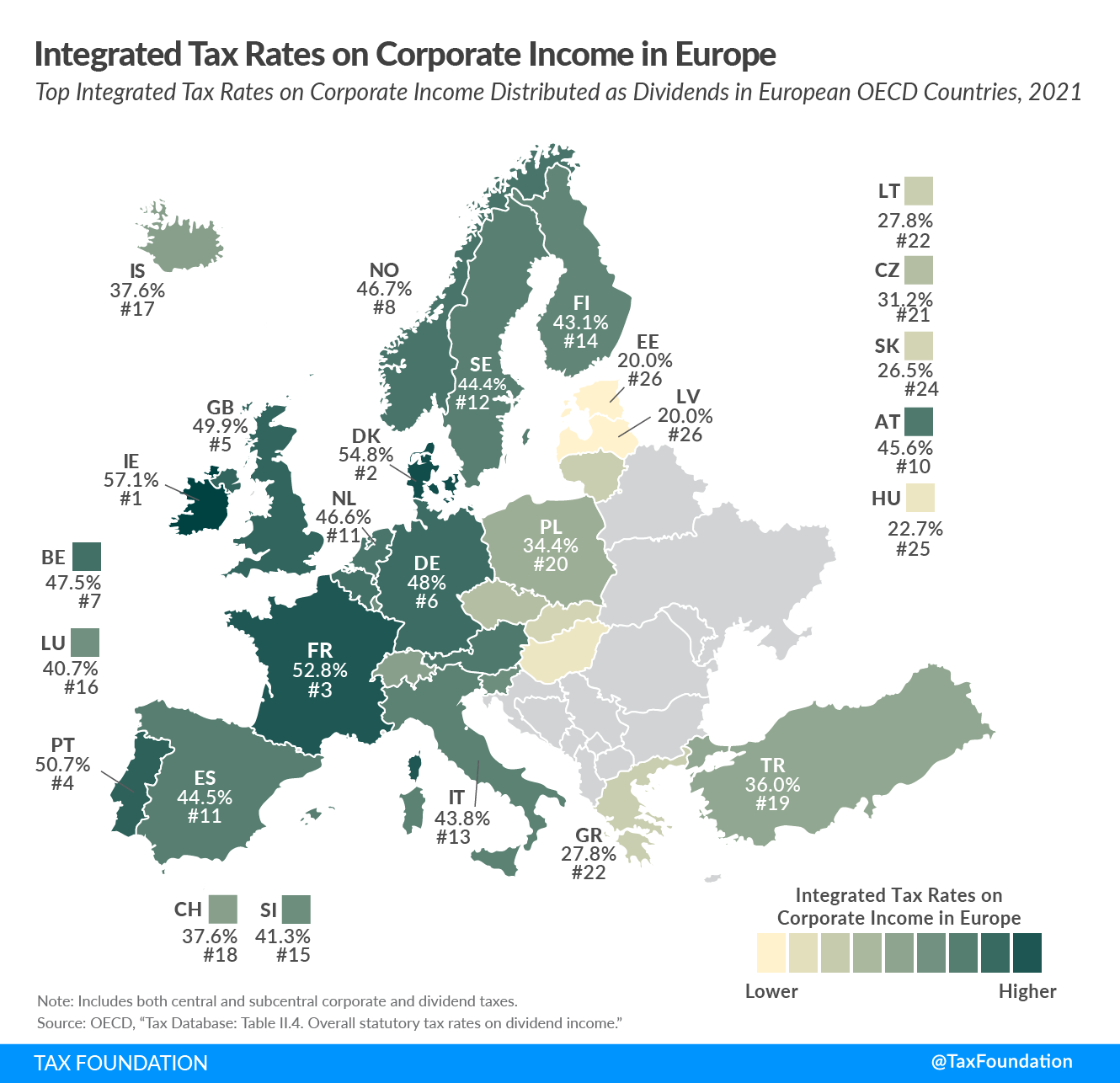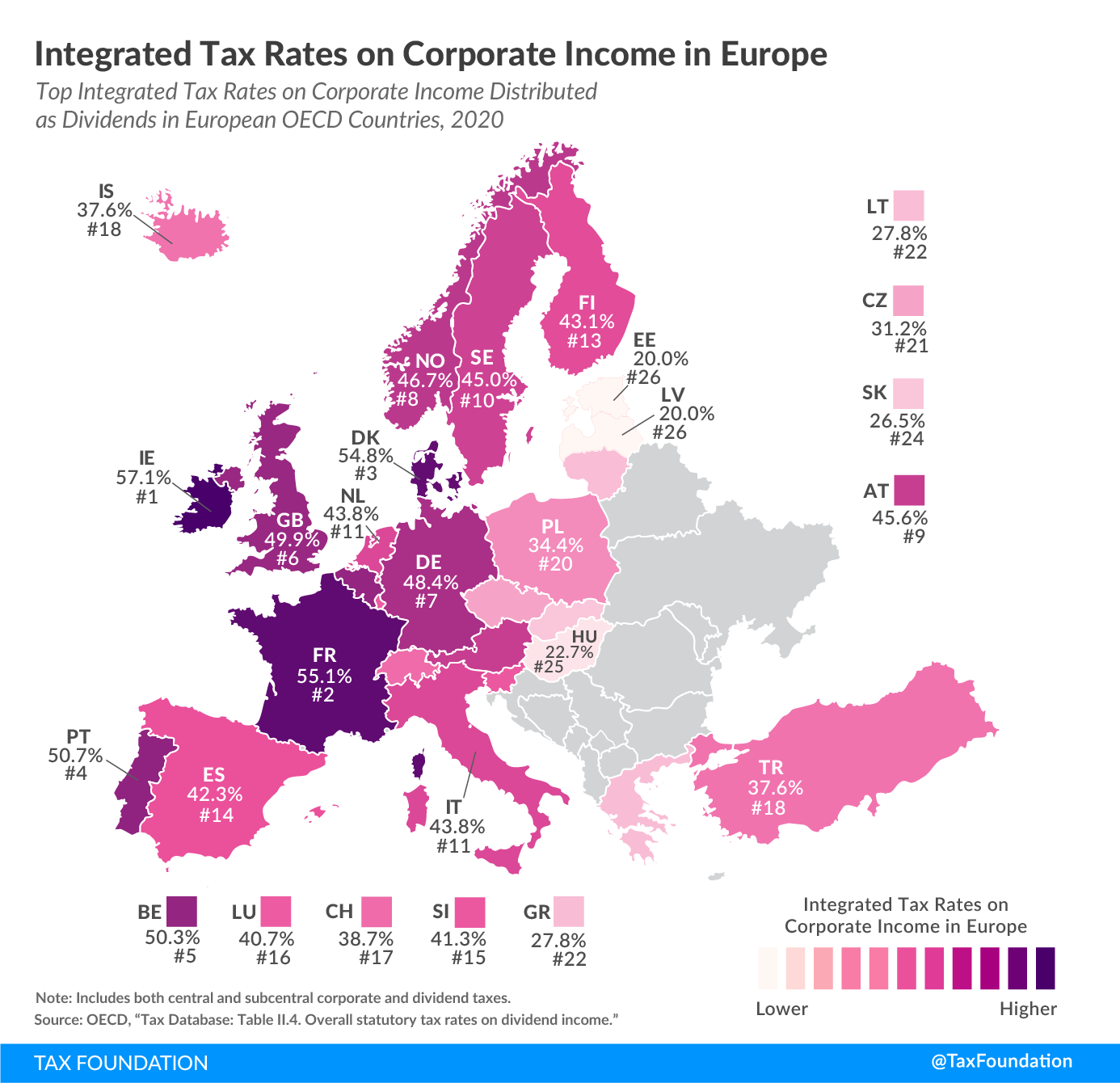
In most European OECD countries, corporate income is taxed twice—once at the entity level and once at the shareholder level. Before shareholders pay taxes, the business first faces corporate income taxA corporate income tax (CIT) is levied by federal and state governments on business profits. Many companies are not subject to the CIT because they are taxed as pass-through businesses, with income reportable under the individual income tax. on its profits. Thus, when shareholders pay their layer of taxA tax is a mandatory payment or charge collected by local, state, and national governments from individuals or businesses to cover the costs of general government services, goods, and activities. , they are doing so on dividends or capital gains distributed from after-tax profits. The integrated tax rate on corporate income reflects both the corporate income tax and the dividends or capital gains taxA capital gains tax is levied on the profit made from selling an asset and is often in addition to corporate income taxes, frequently resulting in double taxation. These taxes create a bias against saving, leading to a lower level of national income by encouraging present consumption over investment. —the total tax levied on corporate income.
As an example, suppose that an Italian corporation earns €100 in profit. It must pay corporate income tax of €24, which leaves the corporation with €76 in after-tax profits. If the corporation distributes those earnings as a dividend, the income is taxed again at the individual level at a top dividend rate of 26 percent, resulting in €19.76 in dividend taxes. Thus, the final after-tax incomeAfter-tax income is the net amount of income available to invest, save, or consume after federal, state, and withholding taxes have been applied—your disposable income. Companies and, to a lesser extent, individuals, make economic decisions in light of how they can best maximize their earnings. is €56.24, implying that the €100 in original corporate profits faces an integrated tax rate on corporate income of 43.76 percent. The same calculation can be done for corporate income realized as capital gains.
Integrated Tax Rates on Corporate Income in Europe, 2024
| Country | Statutory Corporate Income Tax Rate | Top Personal Dividends Rate | Integrated Rate on Corporate Income (Dividends) | Top Personal Capital Gains Rate | Integrated Rate on Corporate Income (Capital Gains) |
|---|---|---|---|---|---|
| Austria | 23.00 | 27.50 | 44.18 | 27.50 | 44.18 |
| Belgium | 25.00 | 30.00 | 47.50 | 0.00 | 25.00 |
| Czech Republic | 21.00 | 23.00 | 39.17 | 0.00 | 21.00 |
| Denmark | 22.00 | 42.00 | 54.76 | 42.00 | 54.76 |
| Estonia | 20.00 | 0.00 | 20.00 | 20.00 | 36.00 |
| Finland | 20.00 | 28.90 | 43.12 | 34.00 | 47.20 |
| France | 25.83 | 34.00 | 51.04 | 34.00 | 51.04 |
| Germany | 29.93 | 26.38 | 48.41 | 26.38 | 48.41 |
| Greece | 22.00 | 5.00 | 25.90 | 15.00 | 33.70 |
| Hungary | 9.00 | 15.00 | 22.65 | 15.00 | 22.65 |
| Iceland | 21.00 | 22.00 | 38.38 | 22.00 | 38.38 |
| Ireland | 12.50 | 51.00 | 57.13 | 33.00 | 41.38 |
| Italy | 24.00 | 26.00 | 43.76 | 26.00 | 43.76 |
| Latvia | 20.00 | 0.00 | 20.00 | 20.00 | 36.00 |
| Lithuania | 15.00 | 15.00 | 27.75 | 20.00 | 32.00 |
| Luxembourg | 24.94 | 21.00 | 40.70 | 0.00 | 24.94 |
| Netherlands | 25.80 | 33.00 | 50.29 | 36.00 | 52.51 |
| Norway | 22.00 | 37.84 | 51.52 | 37.80 | 51.48 |
| Poland | 19.00 | 19.00 | 34.39 | 19.00 | 34.39 |
| Portugal | 31.50 | 28.00 | 50.68 | 28.00 | 50.68 |
| Slovak Republic | 21.00 | 10.00 | 28.90 | 0.00 | 21.00 |
| Slovenia | 22.00 | 25.00 | 41.50 | 0.00 | 22.00 |
| Spain | 25.00 | 28.00 | 46.00 | 0.28 | 25.21 |
| Sweden | 20.60 | 30.00 | 44.42 | 30.00 | 44.42 |
| Switzerland | 19.65 | 22.16 | 37.45 | 0.00 | 19.65 |
| Turkey | 25.00 | 20.00 | 40.00 | 0.00 | 25.00 |
| United Kingdom | 25.00 | 39.35 | 54.50 | 20.00 | 40.00 |
| Average | 21.92 | 24.41 | 40.89 | 18.74 | 36.55 |
| United States (for comparison) | 25.63 | 28.73 | 46.99 | 29.3 | 47.42 |
(a) In some countries, the capital gains tax rate varies by type of asset sold. The capital gains tax rate used in this report is the rate that applies to the sale of listed shares after an extended period of time without a substantial ownership share. While the integrated tax rate on dividends captures subcentral taxes, this may not be the case for all integrated tax rates on capital gains due to data availability.
(b) The US rate on capital gains includes the population-weighted state average of 5.5 percent, the federal rate on long-term capital gains of 20 percent, and the federal NIIT rate of 3.8 percent.
Source: OECD Data Explorer, “Combined (corporate and shareholder) statutory tax rates on dividend income,” last updated September 2024, https://data-explorer.oecd.org/; PwC, “Quick Charts: Capital gains tax (CGT) rates,” https://taxsummaries.pwc.com/quick-charts/capital-gains-tax-cgt-rates; Author’s calculations.
For dividends, Ireland’s top integrated tax rate was the highest among European OECD countries (57.1 percent), followed by Denmark (54.8 percent) and the United Kingdom (54.5 percent). Estonia (20 percent), Latvia (20 percent), and Hungary (22.7 percent) levy the lowest rates. Estonia and Latvia’s tax on distributed profits means that the corporate income tax is the only layer of taxation on corporate income distributed as dividends.
For capital gains, Denmark (54.8 percent), Norway (51.5 percent), and France (51 percent) have the highest integrated rates among European OECD countries, while Switzerland (19.7 percent), the Czech Republic (21 percent), and the Slovak Republic (21 percent) levy the lowest rates. Several European OECD countries—namely Belgium, Czech Republic, Luxembourg, Slovakia, Slovenia, Switzerland, and Turkey—do not levy capital gains taxes for long-held shares without substantial ownership, making the corporate tax the only layer of tax on corporate income realized as long-term capital gains.
On average, European OECD countries levy an integrated tax rate on dividends of 40.9 percent and 36.6 percent on capital gains. In comparison, the United States levies an average integrated top tax rate of 47 percent on dividends and 47.4 percent on capital gains.
Double taxationDouble taxation is when taxes are paid twice on the same dollar of income, regardless of whether that’s corporate or individual income. of corporate income can lead to economic distortions, such as reduced savings and investment, a bias toward certain business forms, and debt financing over equity financing. Several OECD countries have integrated corporate and individual tax codes to eliminate or reduce the negative effects of double taxation on corporate income.
2024 Notable Changes
- Over the past year, some countries have raised their statutory corporate rates, including the Czech Republic (from 19 to 20 percent), Iceland (from 20 to 21 percent), Slovenia (from 19 to 22 percent), and Turkey (from 20 to 25 percent). Others have raised their top personal tax rates on capital gains, such as the Netherlands (from 32 to 36 percent) and Spain (from 26 to 28 percent). In contrast, Austria has reduced its statutory corporate rate from 24 to 23 percent.
- The United Kingdom’s government is planning to raise the top rate on capital gains from the sale of shares from 20 to 24 percent, which would move the country’s integrated tax rate on capital gains from 40 to 43 percent.








